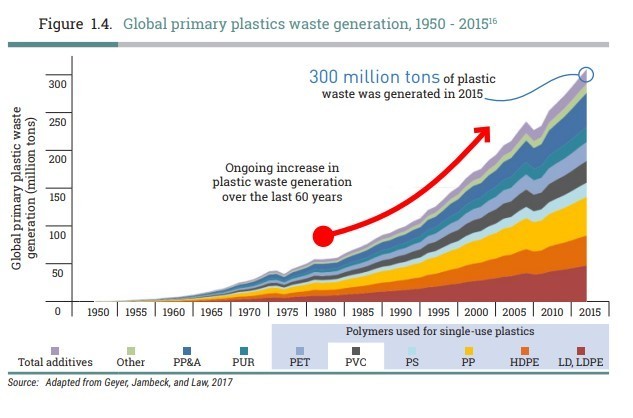This is what countries are doing to fight plastic waste
The world is entering a new era in its relationship with plastic.
What was once a miracle product has become public enemy number one.
Plastic’s success is largely due to the fact that it is cheap and light, revolutionizing safe food storage, helping save lives in the health sector and facilitating the manufacture of wind turbines and solar panels.
And this success has led to the generation of a vast quantity of plastic waste over the past 60 years, as shown in the graph below.

Now however, concerted action is being taken to reverse that trend. More than 50 nations – from the Galapagos Islands to India and from Rwanda to China – are taking action to reduce plastic pollution.
The UN has compiled a list of what each of these countries is doing – and the success they are having – in a new report called Single-use Plastics: A Roadmap for Sustainability.
The aim of the report is to give governments a benchmark for effective policy making.
Black market
The report finds that the bulk of the action being taken is concentrated around the use of single-use plastics.
The graph shows the enormous rise in action in this area from 2014 onwards.

Just this month, India’s Prime Minister pledged to eliminate all single-use plastic in the country by 2022, with an immediate ban in urban Delhi.
The plan announced by Narendra Modi is by far the most ambitious of any nation to date, due to the sheer size of the Indian population and the fact that the country is the fastest growing economy in the world.
Many other European countries have introduced a levy on plastic bags, while China, Kenya and Morocco have implemented a ban on thin plastic bags.
The report states that government levies and bans – when properly planned and enforced – have been among the most effective strategies to limit the overuse of disposable plastic products.
However, some countries, such as Bangladesh and Cameroon, have introduced a ban on plastic bags but have not followed through with appropriate enforcement.
This can lead to a rise in the black market of the bags, or the use of thicker plastic bags that are not covered by the bans, which can end up causing even more damage to the environment.
The report also notes that public-private partnerships and voluntary agreements can be good alternatives to bans, giving consumers time to adjust their behaviour and allowing time for enough affordable and eco-friendly alternatives to hit the market.
A mammoth task
Despite the progress being made, the report also warns that far more needs to be done to reduce the vast flow of plastic into rivers and oceans.
Of the 141 million tonnes of plastic waste that was generated in 2015, just 14% was recycled, as seen in the following chart.

It’s clear that there needs to be a dramatic increase in this recyclability rate if the plastic problem is to be solved. Innovation from the private sector in recyclable materials – such as bioplastics – that can be used for packaging, and new ways to incentivise recycling are just two areas for further development.
“Plastic isn’t the problem. It’s what we do with it,” says Erik Solheim, head of UN Environment.
“And that means the onus is on us to be far smarter in how we use this miracle material.”